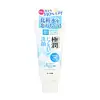What's inside
What's inside
 Key Ingredients
Key Ingredients

 Benefits
Benefits

 Concerns
Concerns

 Ingredients Side-by-side
Ingredients Side-by-side

Water
Skin ConditioningGlycerin
HumectantGlycylglycine
Butylene Glycol
HumectantHydroxypropyl Starch Phosphate
Cocamidopropyl Betaine
CleansingPEG-400
Emulsion StabilisingDecyl Glucoside
CleansingZinc Lauroyl Aspartate
Tea-Cocoyl Glycinate
CleansingSodium Stearoyl Glutamate
CleansingGlyceryl Stearate
EmollientHyaluronic Acid
HumectantHydroxypropyltrimonium Hyaluronate
Citric Acid
BufferingStearic Acid
CleansingLauric Acid
CleansingPEG-32
HumectantDisodium EDTA
Polyquaternium-7
Hydroxypropyl Methylcellulose
Emulsion StabilisingPolyquaternium-52
Methylparaben
PreservativePropylparaben
PreservativeBHT
AntioxidantWater, Glycerin, Glycylglycine, Butylene Glycol, Hydroxypropyl Starch Phosphate, Cocamidopropyl Betaine, PEG-400, Decyl Glucoside, Zinc Lauroyl Aspartate, Tea-Cocoyl Glycinate, Sodium Stearoyl Glutamate, Glyceryl Stearate, Hyaluronic Acid, Hydroxypropyltrimonium Hyaluronate, Citric Acid, Stearic Acid, Lauric Acid, PEG-32, Disodium EDTA, Polyquaternium-7, Hydroxypropyl Methylcellulose, Polyquaternium-52, Methylparaben, Propylparaben, BHT
Water
Skin ConditioningSodium Laureth Sulfate
CleansingCocamide DEA
EmulsifyingCocamidopropyl Betaine
CleansingDisodium Cocoyl Glutamate
CleansingLauryl Glucoside
CleansingAloe Barbadensis Leaf
MaskingBenzoic Acid
MaskingBisabolol
MaskingCaprylyl Glycol
EmollientCitric Acid
BufferingParfum
MaskingGlutaral
PreservativeMaltodextrin
AbsorbentPEG-120 Methyl Glucose Dioleate
EmulsifyingSodium Benzoate
MaskingSodium Chloride
MaskingSodium PCA
HumectantTocopherol
AntioxidantWater, Sodium Laureth Sulfate, Cocamide DEA, Cocamidopropyl Betaine, Disodium Cocoyl Glutamate, Lauryl Glucoside, Aloe Barbadensis Leaf, Benzoic Acid, Bisabolol, Caprylyl Glycol, Citric Acid, Parfum, Glutaral, Maltodextrin, PEG-120 Methyl Glucose Dioleate, Sodium Benzoate, Sodium Chloride, Sodium PCA, Tocopherol
 Reviews
Reviews

Ingredients Explained
These ingredients are found in both products.
Ingredients higher up in an ingredient list are typically present in a larger amount.
Citric Acid is an alpha hydroxy acid (AHA) naturally found in citrus fruits like oranges, lemons, and limes.
Like other AHAs, citric acid can exfoliate skin by breaking down the bonds that hold dead skin cells together. This helps reveal smoother and brighter skin underneath.
However, this exfoliating effect only happens at high concentrations (20%) which can be hard to find in cosmetic products.
Due to this, citric acid is usually included in small amounts as a pH adjuster. This helps keep products slightly more acidic and compatible with skin's natural pH.
In skincare formulas, citric acid can:
While it can provide some skin benefits, research shows lactic acid and glycolic acid are generally more effective and less irritating exfoliants.
Most citric acid used in skincare today is made by fermenting sugars (usually from molasses). This synthetic version is identical to the natural citrus form but easier to stabilize and use in formulations.
Read more about some other popular AHA's here:
Learn more about Citric AcidCocamidopropyl Betaine is a fatty acid created by mixing similar compounds in coconut oil and dimethylaminopropylamine, a compound with two amino groups.
This ingredient is a surfactant and cleanser. It helps gather the dirt, pollutants, and other impurities in your skin to be washed away. It also helps thicken a product and make the texture more creamy.
Being created from coconut oil means Cocamidopropyl Betaine is hydrating for the skin.
While Cocamidopropyl Betaine was believed to be an allergen, a study from 2012 disproved this. It found two compounds in unpure Cocamidopropyl Betaine to be the irritants: aminoamide and 3-dimethylaminopropylamine. High-grade and pure Cocamidopropyl Betaine did not induce allergic reactions during this study.
Learn more about Cocamidopropyl BetaineWater. It's the most common cosmetic ingredient of all. You'll usually see it at the top of ingredient lists, meaning that it makes up the largest part of the product.
So why is it so popular? Water most often acts as a solvent - this means that it helps dissolve other ingredients into the formulation.
You'll also recognize water as that liquid we all need to stay alive. If you see this, drink a glass of water. Stay hydrated!
Learn more about Water